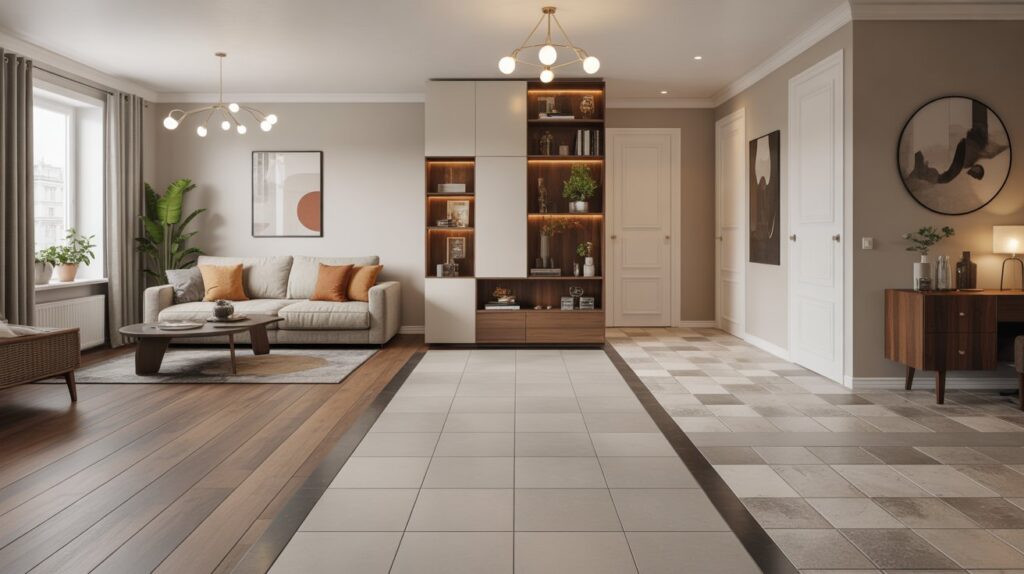Most people approach home design room by room, picking paint colors, furniture, and accessories without thinking about how everything connects. But here’s something that surprises many homeowners: the flooring you choose has more impact on your overall design than almost any other single element. It sets the foundation for everything else-literally and figuratively.
Flooring isn’t just a practical surface to walk on. It’s the backdrop that either makes your design choices work together beautifully or creates that nagging feeling that something’s just not right. The wrong floor can make expensive furniture look cheap, while the right choice can elevate budget pieces and create spaces that feel intentionally designed.
Understanding How Floors Shape Visual Flow
Open floor plans have taught us something important about flooring continuity. When you can see from your kitchen into your living room and dining area, the floor becomes the element that either connects these spaces or creates jarring divisions. Different flooring in each area can make even large homes feel choppy and disconnected.
This is where many homeowners get confused about matching versus coordinating. You don’t need identical flooring throughout your home, but you do need a strategy. The most successful designs use flooring that shares undertones or complementary characteristics. A warm oak in the living areas might pair beautifully with warm-toned tiles in the kitchen, while cool gray floors throughout would clash with that same kitchen choice.
The Science of Color Temperature in Flooring
Color temperature isn’t just for light bulbs-it applies to flooring too. Cool floors (grays, whites, blues) create certain moods and work with specific color palettes, while warm floors (browns, reds, yellows) support entirely different design directions. The problem comes when people mix these temperatures without understanding the visual consequences.
Cool-toned floors tend to make spaces feel larger and more modern, but they can also feel sterile if not balanced with warmer elements elsewhere. Warm-toned floors create cozy, intimate feelings but can make rooms feel smaller or darker if not managed carefully. When you’re exploring options for engineered wood flooring, understanding these temperature differences helps narrow down choices that will actually work with your existing design elements.
Pattern and Texture: The Forgotten Design Elements
Flooring patterns affect how spaces feel in ways most people don’t anticipate. Wide planks make rooms feel more spacious and contemporary, while narrow strips can feel traditional or even cramped in smaller spaces. Herringbone patterns add visual interest but can overwhelm busy rooms that already have lots of competing elements.
Texture plays a similar role. High-gloss floors reflect light and can make spaces feel larger, but they also show every speck of dust and scratch. Matte finishes hide imperfections better but absorb light, potentially making rooms feel darker. The texture you choose needs to work with your lifestyle and your design goals.
How Flooring Affects Furniture and Decor Choices
This is where it gets really interesting. Your flooring choice influences what furniture and decor will look good in your space. Dark floors can make light furniture pop dramatically, but they also show dust and require more maintenance. Light floors are forgiving with dirt but can wash out pale furniture pieces.
The visual weight of your flooring matters too. Heavy, dark floors ground a space and can support bold, dramatic design choices. Light, smooth floors feel more neutral and work well with minimalist designs or rooms where you want the furniture to be the star.
Creating Transitions Between Different Flooring Types
Most homes need different flooring types in different areas-tile in bathrooms, wood in living spaces, perhaps carpet in bedrooms. The key is creating transitions that feel intentional rather than jarring. This often means thinking about sightlines and how different floors will appear when viewed together.
Threshold strips and transition pieces are practical necessities, but they’re also design opportunities. A well-chosen transition can bridge two different floor types elegantly, while a poor choice draws unwanted attention to the change.
The Psychological Impact of Flooring Choices
Different flooring materials and colors affect how we feel in spaces. Natural wood floors tend to feel welcoming and comfortable, while polished concrete might feel modern but cold. Carpet creates acoustic warmth and physical comfort but can make spaces feel more casual.
Understanding these psychological impacts helps create the mood you want in each space. A home office might benefit from flooring that feels crisp and energizing, while a bedroom might need something that promotes relaxation and comfort.
Planning for Long-Term Design Evolution
Interior design trends change, but flooring is a long-term investment. The smartest approach is choosing floors that will work with multiple design directions over time. This usually means selecting something with enough character to be interesting but not so trendy that it will feel dated in five years.
Neutral doesn’t have to mean boring. A well-chosen neutral floor provides a flexible foundation that can support bold accent colors, dramatic artwork, or statement furniture. As your design preferences evolve, you can change accessories and decor without needing to replace expensive flooring.
Budget Considerations and Design Impact
Quality flooring is one of those investments that affects everything else in your home. Cheap flooring can undermine even the most carefully chosen furniture and accessories. On the flip side, beautiful flooring can make budget furniture and decor look more expensive and intentional.
When budget is tight, it’s often better to choose quality flooring and build the rest of the design around it gradually. A great floor will improve your space immediately and provide a solid foundation for future decorating decisions.
Making It All Work Together
Creating cohesive interiors through flooring choices requires thinking beyond individual rooms to consider your home as a connected whole. The most successful designs balance practical considerations with aesthetic goals, creating spaces that both function well and feel intentionally designed. When flooring, color temperature, patterns, and transitions all work together, the result is a home that feels effortlessly coordinated rather than accidentally assembled.

